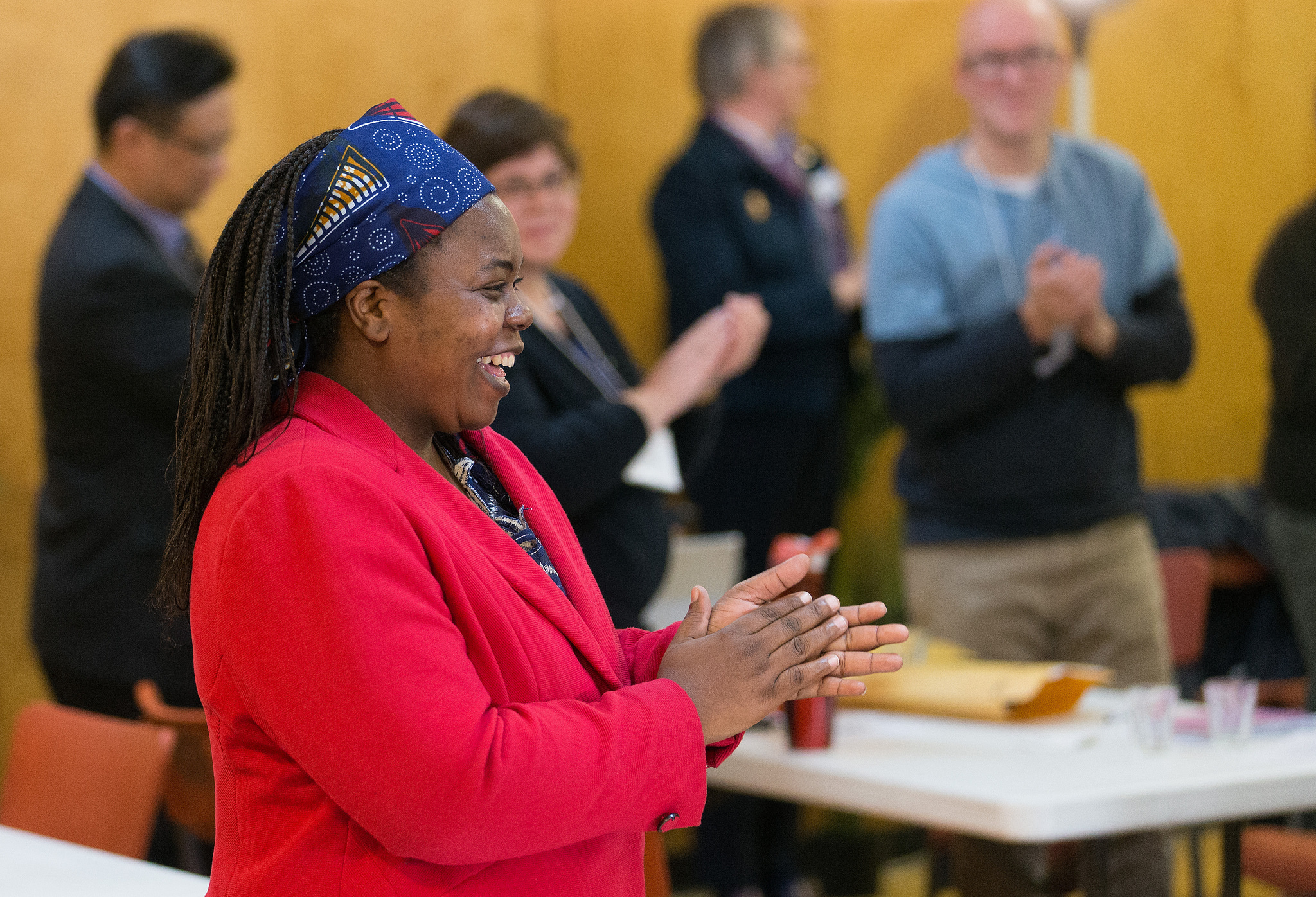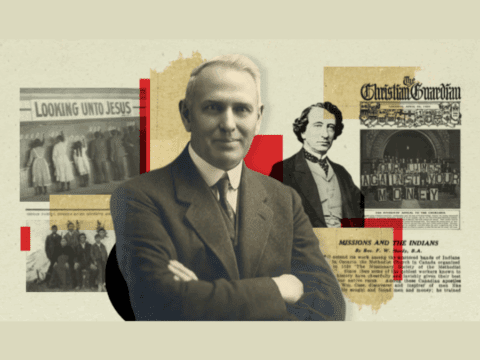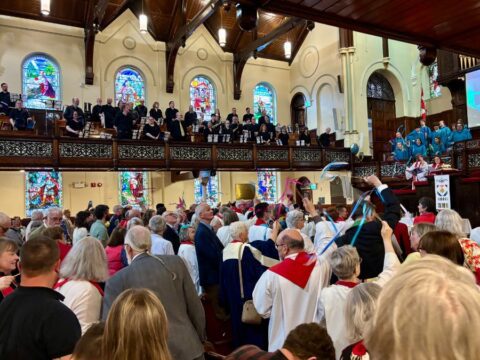As this year ends, likely so will Presbytery. Only one step remains before this major overhaul of The United Church of Canada: this month’s General Council will need to approve the proposal, strongly supported in a church-wide vote, to redesign the denomination’s current four-court structure into three courts fit for a different world.
Presbytery has meant a lot to people, especially in areas where it was the major social link among local churches. It’s been a place where stories were shared, books were displayed, hearts unfolded, leadership grew and, sometimes, hard rules were applied to ministry colleagues. National church initiatives such as boycotts and emergency responses would gain traction, as would new church directions and programs. Proposals and votes would move from one part of the church to another through Presbytery. It just seems right to reflect on its passing, mourn a little and let it go.
When the United Church was formed in 1925, the framers of the Basis of Union mostly kept the responsibilities and names of the uniting churches’ various courts, interlocking them into a conciliar system they hoped would give “substantial local freedom, and at the same time secure the benefits of a strong … co-operative efficiency.”
Presbytery was key, connecting local pastoral charges with Conferences and the national General Council. Members included ministers and a representative group of laypersons from each of the pastoral charges. Regular Presbytery meetings, some monthly and some every few months due to distance, considered the work of the congregations, including oversight of property, records and — until recently — the education of ministry candidates, the covenanting of ministers and congregations, and any discipline of ministers.

Presbyteries played a critical role in developing the United Church ethos after union, notably with the issue of ordaining women. In the pattern of the uniting churches, women could do church work but not in an ordained role. Lydia Gruchy, who had studied theology at St. Andrew’s Theological College in Saskatoon, worked as a trained lay leader, particularly among immigrants, in rural parts of the province. The church took notice of her. It seemed ridiculous to Gruchy’s supporters that someone of her ability couldn’t preside at the sacraments. Various Presbyteries started pressing for her ordination.
A proposal to ordain Gruchy was made, but to do so legally, the Basis of Union would need to be amended through a vote (called a remit) of all the Presbyteries. The result from these on-the-ground groups across the country was strongly in favour. Gruchy was ordained in 1936.
Over the years, Presbyteries would continue to be gatherings where new ideas and social justice initiatives would be discussed and often move into action. Betsy Anderson of Toronto Southeast Presbytery first got involved in Presbytery as a theological student in the 1980s. She remembers engaging with wider church issues, such as including children in the life of the church and the eligibility of gay and lesbian persons for ministry.
“Overall, I bought into the idea of the conciliar church and the sense that we were not church alone in our specific congregations, but church together,” she says. “It could, and did, help us to change and be transformed. It was a vehicle for the work of the Spirit.”
Former United Church moderator Mardi Tindal fondly recalls her visit to Kootenay Presbytery in southeastern British Columbia in April 2012. Like other Presbyteries with geographic challenges, Kootenay gathers for a weekend, generally twice a year. Some people travel six hours to be there.
“Throughout the weekend, people shared deeply,” she says. “I particularly remember stories of ecological suffering and hope.” She was also impressed with their ability to listen deeply and make the most of different perspectives. “This Presbytery was extraordinary in its ability to articulate its place in the mending of God’s world.
Presbyteries played a critical role in developing the United Church ethos after union, notably with the issue of ordaining women.
Presbyteries on the whole were good at helping people make connections. “Presbyteries have been places where non-Indigenous churches have been challenged to engage in deepened and authentic relationships with Indigenous United churches on Indigenous terms,” says Kim Uyede-Kai of Hamilton Conference.
Another of Presbytery’s strengths was the opportunity to hear testimony of people’s faith journey and call to ministry, recalls Rev. Rhian Walker of Vancouver Burrard Presbytery. “Walls came down, trust was built, hurt was healed and real relationships were built.”
And then there was the food: turkey dinners, ham and scalloped potatoes, even the hospitality of fresh muffins on arrival. The communal meal at each meeting brought out the goodness in everyone, says Mary MacDermid, a retired designated lay minister who was part of Pictou Presbytery in rural Nova Scotia. “When we have that time to be present to one another in this way, we carry out the work of God and the church in a more faithful way. With bellies and spirits full — bring on the agenda!”
Presbytery was a venue for children’s and youth programming across the country. Presbytery-run summer church camps and retreats were a place to make friends while experiencing energetic worship and real-world applications of scripture. Long before online dating, many relationships grew out of Presbytery young adult groups.
Rev. Kenji Marui says he is indebted to Huron-Perth Presbytery in southwestern Ontario for his faith, sense of self-worth, ministry and life. “This is not an overstatement,” he says. “I was not a cool kid in high school. I didn’t party; I didn’t play hockey. I went to church instead. … Through the work of Presbytery, I learned the power of community.”

Alongside Presbytery’s achievements and the deep meaning it holds for many, it has also had a history of failing to rise to the hopes of the framers of union. Discussions could get unwieldy and go off track, and the work could pile up. Few Presbyteries could afford staff, and so leaders often felt overwhelmed as congregational employment details and legal issues got more complex.
Just two decades after church union, a report emerged criticizing Presbyteries’ function. It pointed to a disconnect between the proceedings of the General Council and local churches. Presbyteries’ chief role in making that link was not working.
This warning was followed by an organizational upheaval that raced through the church in the 1960s. “Lines of authority became horizontal rather than hierarchical,” says Phyllis D. Airhart, a historian at Emmanuel College in Toronto. “Decision-making [became] participatory rather than delegated to leaders, and action [came] from the bottom up rather than top down.” Instead of people sitting in pews at meetings, facing toward a speaker at a lectern or high table, round tables emerged, symbolizing the new way of consultative community.
Presbyteries continued to be an observed problem. A report to the 1980 General Council described them as being in “a real malaise,” with a lack of clear-cut mission, cumbersome structure and few staff. A three-court solution without Presbytery was proposed but rejected.
One of Presbytery’s key roles has been to provide oversight of ministers and congregations. At its best, this function gave congregations and ministry colleagues the opportunity to encourage and build one another up. In practice, though, it was hard to hold one another to account. It was a Gospel test, a challenge for working together as Christians that often suffered in application or was simply avoided.
Rev. Dan Chambers, who came north from the United Church of Christ in California 18 years ago, remembers being shocked to discover the tedium and frequent burden of the monthly meeting in Vancouver- Burrard Presbytery. He says that changed a few years ago.
The Effective Leadership Project, approved by the General Council in 2012 and piloted across the country, led to the shifting of pastoral relations work from Presbytery to Conference. It made a big difference.
“Presbytery became a court where we were supporting each other,” says Chambers. “The relational temperature changed. Trust increased. We no longer had the burden of those former requirements.”
Once that work was gone, there was relief — but an essential part of the machine was gone, too. The end would surely come.
“I am not naive, thinking that in the former order all was rosy and efficient,” says Rev. Peter Wyatt, former principal of Emmanuel College, “but I do count as loss the ability to support and hold one another accountable at closer range.” He says that without Presbyteries, many small pastoral charges will lose touch with the larger church. “Some of them will lose their way entirely, especially in negotiating transitions with ministers. I lament the loss of an era and of an ecclesial ideal.”
“I was not a cool kid in high school. I didn’t party; I didn’t play hockey. I went to church instead. … Through the work of Presbytery, I learned the power of community.”
Last year, I went to six Presbyteries across B.C. Conference to offer some background on the One Order of Ministry remit. There was a consistent worry about the church’s proposed reorganization: What will the future be like for us once this part of the church ends? How will we form “networks and clusters” beyond the congregation as the new model suggests?
Experiments have begun. A small group of Vancouver ministers recently gathered to begin to talk about common concerns — without the weight of a formal Presbytery structure. A few years ago, Living Waters Presbytery in Toronto Conference helped fund collaborative learning groups for laity and clergy. Making an agreement to meet, discuss and learn together allowed growth and support to flourish. This transition time creates valuable new opportunities for congregations and leaders alike.
As Presbytery prepares to pass on, we might take comfort in historian John Webster Grant’s description of the early United Church in his book The Canadian Experience of Church Union: “On the one hand, it was the sum and continuation of the uniting Churches. On the other, it was a company of men and women who were no longer committed to partial traditions but free to follow the leading of the Holy Spirit in a new land.”
Perhaps a newer church, without Presbytery, will be led to gather in that same way.
This story first appeared in The Observer’s July/August 2018 edition with the title “A fond farewell.”














